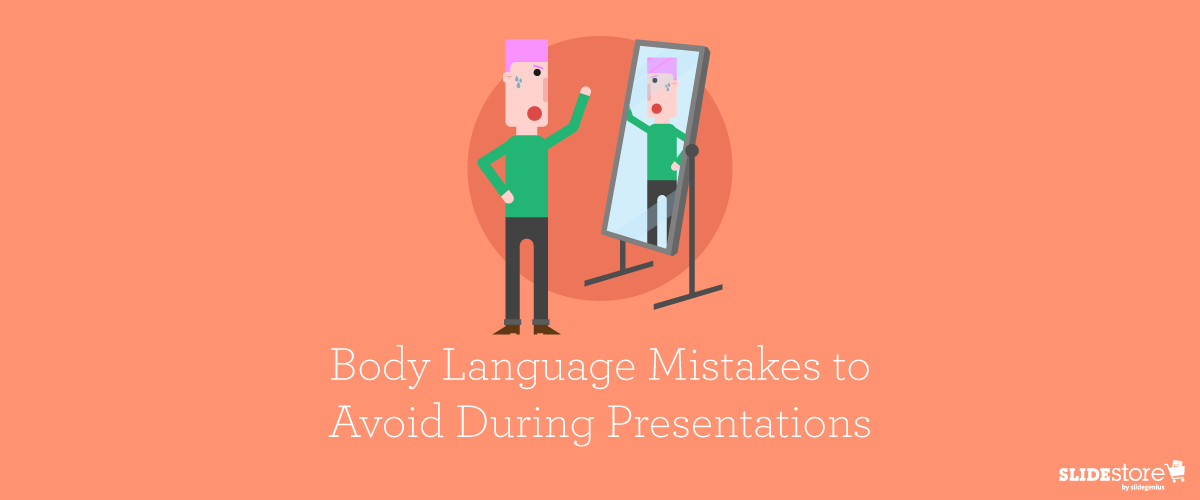When you’re conversing with someone, which of the following do you do: look at that person in the eye or look away? focus or check your watch every few seconds? listen or play with your fingers, seemingly absentminded?
There are many negative connotations when you answer the latter for every pair. That’s because arbitrary cognition affects how people perceive your actions. In short, body language. The more negative those perceptions are, the more badly it reflects upon you, especially when you’re onstage and speaking in front of a large crowd.
But what specific “negative body language” indicators do you have to avoid during a presentation? Below are a few.

Poor Posture
If anything, this will be the most glaring and most obvious presentation blunder you can make. Slumped shoulders and slouching are its two biggest indicators, and they already tell much: nervousness, little to no confidence, a feeling of discomfort and inferiority, and that hint of the “I don’t really want to be here” idea. Poor posture reflects as much on your audience as it does to your own body.
Instead, practice proper posture in front of a mirror. A straight body not only improves bodily functions, like blood circulation, breathing, and the like, but also exudes an air of confidence and self-worth. Then, when you’re in front of your audience, do the same and think of it as your power pose. They will perceive you as a professional with the right things in mind to be worth their time.
Crossing Arms
Defensiveness is not a new concept. Humans survived basically because of it. But when talking about body language, it’s not a good thing; it gives off the message that you aren’t receptive to anything, are resistant to everything except yourself, and would rather stay in your comfort zone—three things you wouldn’t want your audience to emulate because, by then, your words will fall on deaf ears.
What do you do with your hands then? A good trick is incorporating hand movements to your spiel. If you’re about to introduce a point, motion to the audience. If you want a word or phrase emphasized, you can point to your presentation. You can also address to your viewers with a welcoming wave using both hands.

Exaggerated Gestures
Moving around the stage is good. It makes your speech lively with movements and can even draw attention to you and/or to what you’re pointing to, especially when emphasizing points (see above). But there is such a thing as “over the top.”
There should be a limit. If you use exaggerated gestures, like doing a sweeping wave when a small movement of the hand is enough, you can be seen as trying too hard or being too theatrical; the latter isn’t necessarily bad, per se, but if what you’re doing diverts your audience’s attention away from your words, then it’s time to keep your actions in check or, at least, dial it down a notch.
Turning Your Back
There’s a reason live TV strictly discourages showing its stars’ back to the camera: it’s to show the faces of the actors and actresses, the best tools they can use to portray the emotions the scene evokes.
It’s the same with public speaking. What would you rather your audience see: your back or your face? Choosing the former can denote that you’re not really interested in seeing them—much more talk to them. The worst perception is that you don’t trust and respect your viewers. Soon, they’ll reciprocate that feeling and think they just wasted their time.

Make Eye Contact
Have you ever had a conversation with an individual where your eyes just don’t meet, and you feel more awkward with each passing moment? Not having eye contact gives off the air and sentiment that much of what happens isn’t worth the time and could be just safely ignored. Thus, trust isn’t formed.
Looking at your audience members eye to eye fosters better understanding of each other because of the sincerity and trust that comes with it. You feel there’s a deeper connection steadily forming from that connection. The more it develops, the more your audience sees what makes you stand and speak in front of them: “confidence, leadership, strength, and intelligence,” as Dr. Travis Bradberry, author of Emotional Intelligence 2.0, writes.
When it comes right down to it, when hundreds of pairs of eyes are on you, there’s no greater fear than making a mistake and humiliating yourself. With the wrong kinds of body language, you’re just digging your grave deeper. When you’re rehearsing, take extra care and effort to eliminate these habits, no matter how much of a mannerism they have become. It’ll serve you better in the long run.
Resources:
Babar, Tayab. “8 Fatal Body Language Mistakes to Avoid During Presentations.” Lifehack. n.d. www.lifehack.org/articles/productivity/8-fatal-body-language-mistakes-avoid-during-presentations.html
Bradberry, Travis. “13 Body Language Blunders that Make You Look Bad.” Huffington Post. March 4, 2017. www.huffingtonpost.com/entry/13-body-language-blunders-that-make-you-look-bad_us_58b88c2fe4b02eac8876cc70
Chernoff, Marc. “25 Acts of Body Language to Avoid.” Marc & Angel Hack Life. July 7, 2008. www.marcandangel.com/2008/07/07/25-acts-of-body-language-to-avoid
Economy, Peter. “9 Body Language Habits That Make You Look Really Unprofessional.” Inc. May 13, 2016. www.inc.com/peter-economy/9-body-language-habits-that-make-you-look-really-unprofessional.html
Grickej, Peter. “5 Negative Effects of Bad Posture on Your Body and Mind.” Posturebly. June 20, 2014. www.posturebly.com/5-negative-effects-of-bad-posture-on-your-body-and-mind
Herold, Cameron. “5 Absolute Worst Body Language Mistakes Made at Work.” COO Alliance. November 16, 2016. www.cooalliance.com/blog/communication/5-absolute-worst-body-language-mistakes-made-at-work
Navarro, Joe. “The Psychology of Body Language.” Psychology Today. November 29, 2009. www.psychologytoday.com/blog/spycatcher/200911/the-psychology-body-language
Smith, Jacquelyn. “The 11 Worst Body Language Mistakes Professionals Make.” Business Insider. April 17, 2014. www.businessinsider.com/common-body-language-mistakes-employees-make-2014-4








